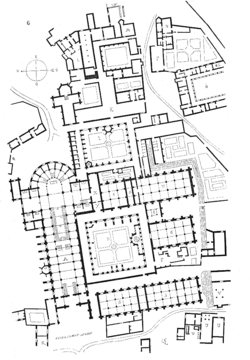- Clairvaux Abbey
-
Clairvaux Abbey (Clara Vallis in Latin) is a Cistercian monastery in Ville-sous-la-Ferté, 15 km from Bar-sur-Aube, in the Aube département in northeastern France. The original building, founded in 1115 by St. Bernard, is now in ruins; a high-security prison, the Clairvaux Prison, now occupies the grounds. Clairvaux Abbey was a good example of the general layout of a Cistercian monastery. The Abbey has been listed since 1926 as a Historical monument by the French Ministry of Culture.
Description
Cistercian monasteries were all arranged according to a set plan unless the circumstances of the locality forbade it. A strong wall, furnished at intervals with watchtowers and other defenses, surrounded the abbey precincts. Beyond the wall, a moat, artificially diverted from tributaries which flow through the precincts, completely or partially encircled the wall. This water furnished the monastery with an abundant supply of water for irrigation, sanitation and for the use of the offices and workshops.
An additional wall, running from north to south, bisected the monastery into an "inner" and "outer" ward. The inner ward housed the monastic buildings while the agricultural and other menial endeavors were carried out in the outer ward.
The precincts were entered by a gateway, at the extreme western extremity, giving admission to the lower ward. Here the barns, granaries, stables, shambles, workshops and workmens lodgings were located without any regard to symmetry, convenience being the only consideration. A single gatehouse afforded communication through the wall separating the outer from the inner ward. On passing through the gateway, the outer court of the inner ward was entered, with the western facade of the monastic church in front. Immediately on the right of entrance was the abbot's residence, in close proximity to the guest-house. On the other side of the court were the stables, for the accommodation of the horses of the guests and their attendants. The church occupied a central position. To the south was the great cloister, surrounded by the chief monastic buildings. Further to the east, the smaller cloister contained the infirmary, novices' lodgings and quarters for the aged monks. Beyond the smaller cloister and separated from the monastic buildings by a wall, lay the vegetable gardens and orchards. Large fish ponds were also located in the area east of the monastic buildings. They were an important part of monastic life and much care was given to their construction and maintenance by the monks. The fish ponds often remain as one of the few visible traces of these vast monasteries.
The church consists of a vast nave of eleven bays, entered by a narthex, with a transept and short apsidal choir. To the east of each limb of the transept are two square chapels, divided according to Cistercian rule by solid walls. Nine radiating chapels, similarly divided, surround the apse. The stalls of the monks, forming the ritual choir, occupy the four eastern bays of the nave. There was a second range of stalls in the extreme western bays of the nave for the lay brothers. The cloister was located to the south of the church so that its inhabitants could benefit from ample sunshine.
The chapter house opened out of the east walk of the cloister in parallel with the south transept.
See also
External links
- Official website of the Claravallis Association for a Clairvaux Foundation (French) (English)
Categories:- Cistercian monasteries in France
- 1115 establishments
- Religious organizations established in the 1110s
- Buildings and structures in Aube
- Christian monasteries established in the 12th century
Wikimedia Foundation. 2010.

